Eight Benefits of Glycerine for Skin Care
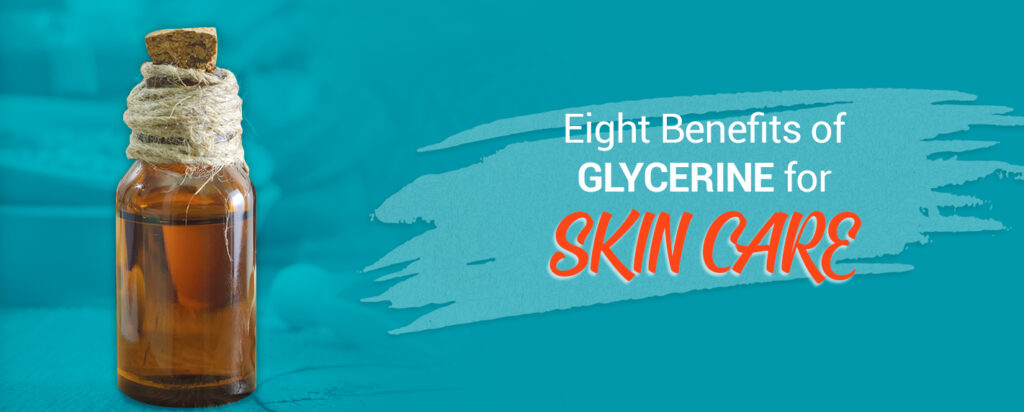
Jump to:
- What is Glycerine?
- Uses of Glycerine for Skin Care
- Glycerine Benefits for Skin
- Ways to Add Glycerine to Your Skin Care Routine
- Buy Natural Glycerine for Skin Care
Glycerine is one of the most valuable substances in the world and is found in a wide variety of everyday products. Due to its outstanding moisturizing properties, glycerine is commonly used in skin care products. Whether you only use natural skin care products or household brands, it’s highly likely you’ll find glycerine on labels throughout your home.
Glycerine may sound like a foreign chemical, but natural glycerine exists in all animal and vegetable matter. Glycerine has many uses and benefits when it comes to beauty and skin care, but not all glycerine products are created equal. In this post, we’ll explain how glycerine works wonders for skin, how you can add glycerine to your skin care routine and which type of glycerine to use for maximum benefits.
What is Glycerine?
Glycerine, also often called glycerol or glycerin, is a colorless, odorless, syrupy liquid with a sweet flavor. In terms of chemical composition, glycerine is a trihydroxy sugar alcohol. The name glycerol comes from the Greek word “glykys,” which means “sweet.”
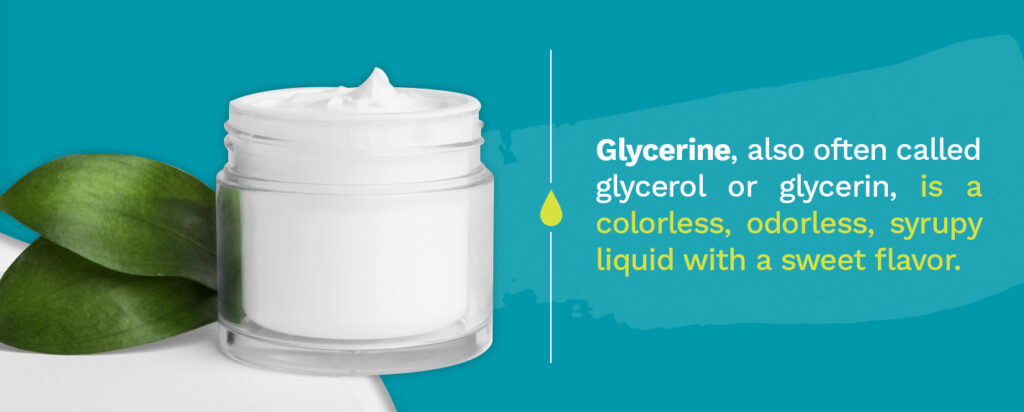
Glycerine can be natural or synthetic. Natural glycerine is produced as a result of hydrolysis of animal or vegetable fats. Hydrolysis is when a substance reacts to water and a chemical bond breaks down as a result. Synthetic glycerine is produced through chemical processes involving petroleum, propylene and chlorine.Chemist Carl Wilhelm Scheele first discovered glycerine in 1778. However, glycerine had been around far before the 18th century. For example, soap-making using animal fats is described in Sumerian clay tablets dating back to the third millennium B.C. Today, glycerine has more than 1500 known end uses and can be found in products from cosmetics to foods.
Why is Glycerine Beneficial for Skin?
Glycerine is a versatile humectant used in skin care products to hydrate and moisturize. It pulls water from the second layer of the skin and brings it to the top layer of the skin. If the humidity is high, humectants also draw moisture from the air. Its properties make it ideal for cleansers, lotions, and soaps that help to improve skin texture and maintain softness for all skin types.
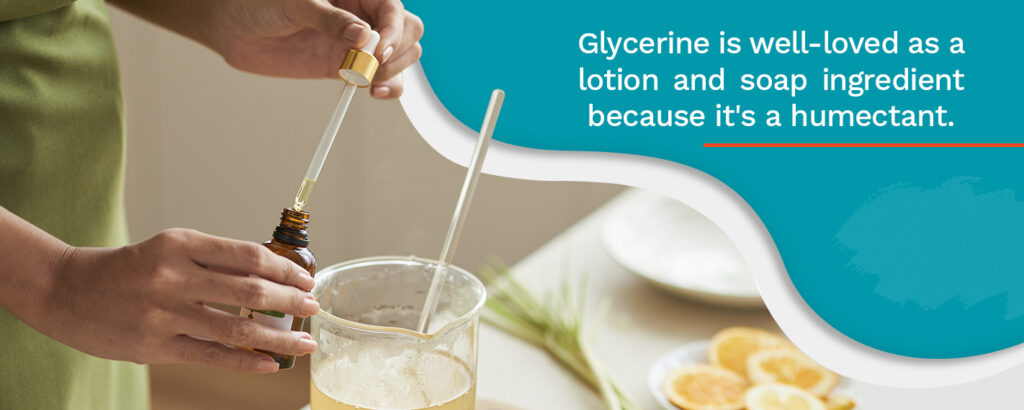
Due to it’s gentle, moisturizing qualities, glycerine is a preferred soap ingredient for individuals with sensitive skin. Pure glycerine soap will not dry out the skin or make it itchy and irritated like harsh soaps with fragrances and various chemicals. Strong soap can wash away the skin’s natural oils and dry out the skin, which can lead to a range of issues. Glycerine, on the other hand, keeps skin moist and soft while gently cleaning the skin. Because glycerine is so effective as a skin moisturizer, you can find it in products such as:
- Cleansers: Glycerine won’t add oil to the skin or clog pores, making it an excellent cleanser for individuals who have acne-prone skin. Any skin type can use facial cleansers containing glycerine to wash away dirt and grease without drying out their skin.
- Toners: Toners containing glycerine are a great way to freshen the skin without making skin feel sticky or greasy. Glycerine toners allow individuals with naturally oily skin to hydrate their skin with a light, refreshing mist.
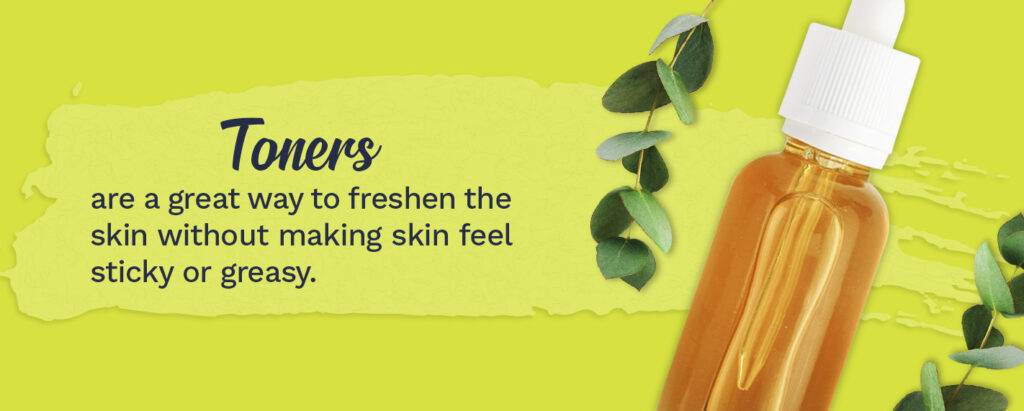
- Sunscreen: Sunscreen helps guard the skin against damaging UV rays. Glycerine can be found in some sunscreens as a natural moisturizer and to help make the sunscreen more spreadable.
- Moisturizers: Glycerine’s most impressive feature is its moisturizing capabilities. As a humectant, glycerine can be found in many moisturizing products like face creams and hand and foot lotions — just to name a few. As glycerine draws moisture to the skin’s surface, it fills in wrinkles for a smooth, soft feel and appearance.
- Face Masks: Some face masks contain glycerine to brighten and moisturize skin. You can use a glycerine face mask for fast hydration and immediate age-defying results.
- Soaps: Glycerine is commonly found in many different types of soaps and body washes. Because glycerine is gentle and won’t dry out the skin, it is also a common ingredient in baby skin products.
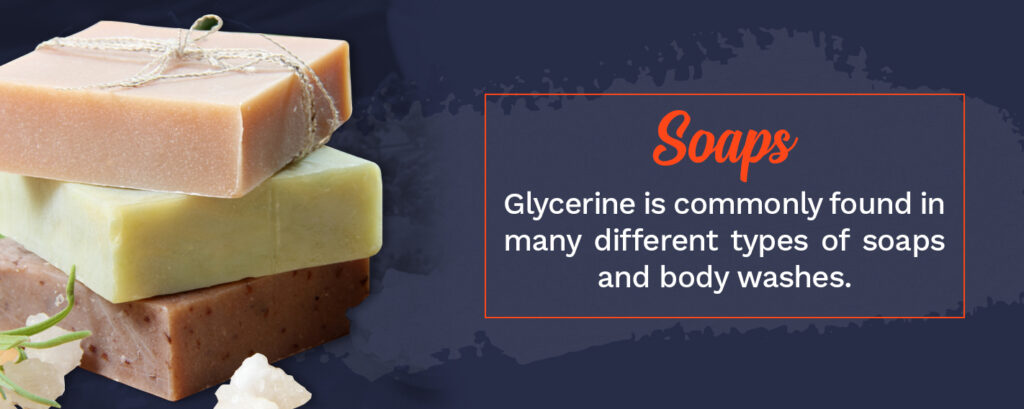
What Are the Benefits of Glycerine for Skin?
Glycerine offers several benefits for the skin, including:
1. Reducing the effects of aging
2. Reducing acne and clogged pores
3. Moisturizing skin safely
4. Gentle exfoliation without irritation
5. Healing dry and cracked skin
6. Keeping skin hydrated
7. Protecting skin from cold and dry weather
8. Containing antibacterial, antifungal and antiviral properties
There are many benefits of glycerine in skin care, whether you have oily skin, sensitive skin or dry skin. All-natural, pure glycerine skin care products also have no harmful impact on the environment. If you choose vegetable glycerine, you can also feel good about using products that did not involve animal harm.
Let’s explore the top eight benefits of using natural glycerine for skin care, as well as why you’ll want to include it in your daily routine and DIY skin care products.
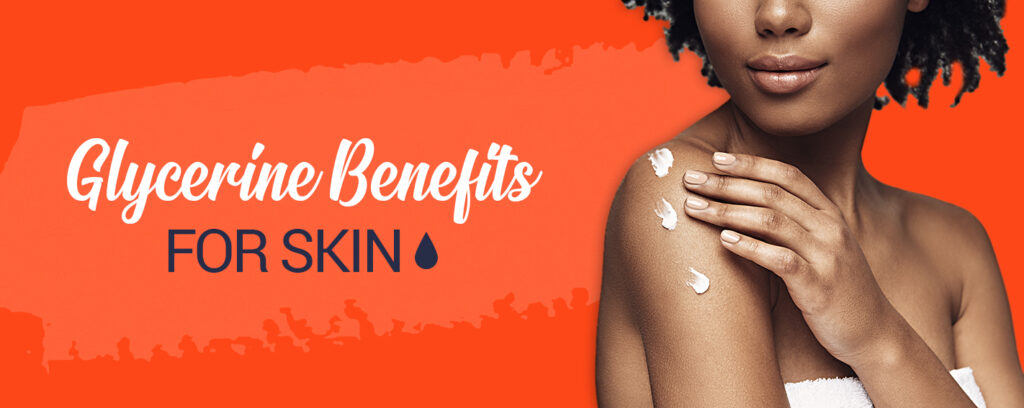
1. Keeps Skin Young
Applying glycerine to your skin traps moisture in your skin and gives it a youthful, healthy glow. By drawing moisture to the top layer of skin, glycerine helps reduce the appearance of wrinkles and keeps skin looking soft and smooth.
Glycerine also improves skin function to slow down aging. For example, a study published in the Journal of Investigative Dermatology shows that glycerine may also help skin cells mature properly. Glycerine helps guide young skin cells from the deepest layers to the surface to form the skin’s protective barrier. As a result, glycerine makes skin look, feel and function better overall.
To reduce premature skin aging, the American Academy of Dermatology (AAD) recommends applying a facial moisturizer every day and cleaning your skin gently. They also recommend washing your face after sweating heavily and to discontinue using skin care products that burn or irritate your skin. Glycerine is the perfect ingredient for gentle cleaning and moisturizing.
2. Reduces Acne
Some ingredients commonly found in cleansers and moisturizers for acne are actually too harsh for the skin. Strong skin care products can make acne worse for some individuals by causing inflammation and irritation. Glycerine, however, can be used to beautify your skin without the side effects of harsher products.
Also, glycerine is oil-free and non-comedogenic, meaning it won’t clog your pores. Clogged pores lead to breakouts, so glycerine for oily skin may be the right solution.
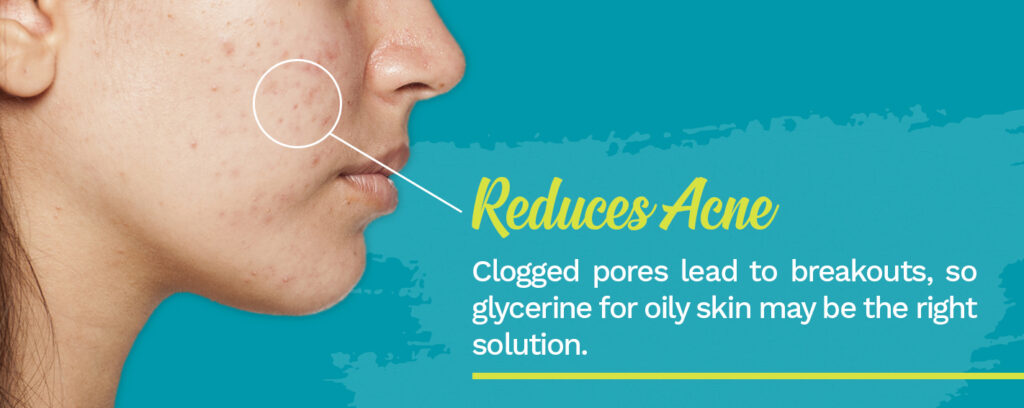
3. It’s Safe
When it comes to choosing skin care ingredients, you’ll want to consider safety above all else. Your skin plays a critical role in protecting your body by keeping fluids in, keeping harmful bacteria and viruses out and regulating your body temperature even. Therefore, you’ll want to use safe products that promote healthy skin.
Some perfumes and chemicals can dry out the skin, clog the pores or cause irritation. Glycerine will not clog pores or dry out the skin, and it’s safe to use. According to the Food and Drug Administration (FDA), glycerine is generally recognized as safe. To illustrate glycerine’s safety level, consider that glycerine is used in over 120 baby products and more than 15,000 cosmetic products. According to the Cosmetic Ingredient Review, there were no signs of toxicity or adverse effects when human subjects were orally administered glycerine in orange juice with each meal for 50 days.
4. It’s Gentle
Gentle cleansers and moisturizers are important for keeping skin comfortable and healthy, especially for individuals who are prone to acne. Acne-prone individuals are often told to use exfoliators to remove dead skin cells. Gritty, abrasive scrubs can remove dead skin cells and leave skin feeling soft, but they can also be too harsh for acne-prone skin and cause further irritation and redness where there’s a breakout.
Glycerine offers a gentle way to exfoliate, clean and moisturize skin without causing irritation. Individuals with acne want to remove dirt and oil when cleaning their skin, but they also want to make sure they’re gentle with the outer layer of skin. Gentle cleansers that include glycerine are ideal for individuals with dry skin, as well. It’s important for all skin types to treat their skin gently and prevent irritation.
5. Heals Skin
Where the skin is dry, damaged and cracked, glycerine can come to the rescue and increase skin hydration. Glycerine may be used to help skin conditions like eczema or psoriasis and to help heal wounds resulting from cracked skin. Overall, glycerine promotes skin health by improving skin function, accelerating the wound healing process, and protecting skin against irritants. Glycerine has even demonstrated antimicrobial effects.
6. Moisturizes Skin
Glycerine acts like a sponge and draws more moisture to itself. It also helps slow down the evaporation of water from the skin, which can help keep skin moist and hydrated in the middle of winter.
Several scientific studies provide evidence that glycerine effectively moisturizes and hydrates skin. For example, a study published in the Asian Journal of Beauty and Cosmetology compared creams containing glycerine to creams that did not contain glycerine. Researchers found that the cream containing both glycerine and silicone oil had the highest moisturizing value and held hydration the longest compared to the cream that did not contain glycerine. The cream with glycerine showed a superior ability to boost skin hydration and decrease water loss.
Another study published in The Journal of the Japanese Society of Balneology, Climatology and Physical Medicine investigated the effects of adding glycerine to bath water and dry skin. Researchers found that participants who bathed in water with glycerine experienced significant improvement in skin moisture levels at the forearm and forehead, and higher skin moisture levels in other areas of the body compared to the group that did not use glycerine. They concluded that a bath of glycerine and warm water maintains skin moisture and prevents skin disorders.
Lastly, a study published in 2015 concluded that glycerine has considerable anti-irritant and anti-inflammatory properties.
7. Protects Skin
During the winter, humidity levels drop outside, and cold air causes moisture in your skin to evaporate quickly. As a result, winter air can make skin dry, cracked and flaky. When skin breaks down, it becomes more susceptible to wounds and infection. A moisturizing lotion containing glycerine locks moisture in your skin and can be especially helpful in protecting hands, feet, elbows, knees and other parts of the body that typically get dry. Glycerine can also help protect skin from the effects of wind or dry indoor air.
To further protect your skin, it’s a good idea to apply skin-moisturizing glycerine after showering. Glycerine will help hold moisture in your skin after you wash the natural oils away from your body. You might choose glycerine soap rather than soaps that contain harsh detergents to keep skin soft, smooth and protected. You can incorporate glycerine in your routine every day to benefit from its hydrating qualities year-round.
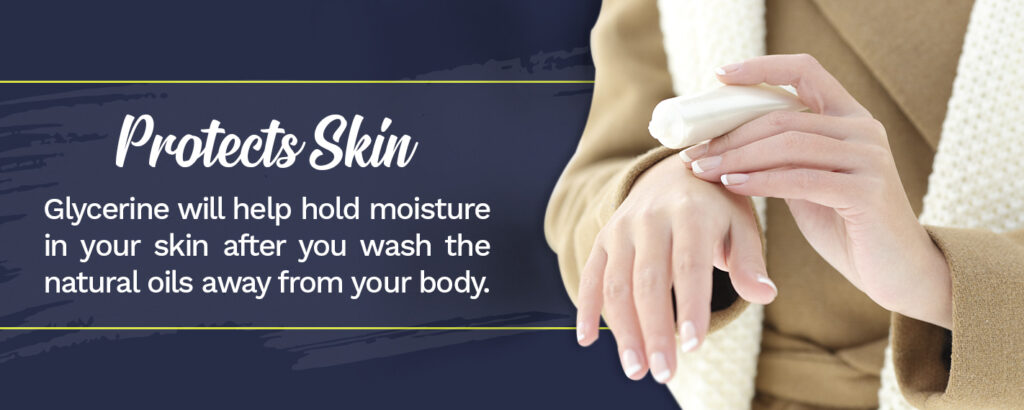
8. Preserves Other Ingredients
If you create your own glycerine skin care products for consumers or personal use, you’ll be pleased to know that glycerine acts as a preservative in addition to all of its other health benefits. According to the United States Department of Agriculture (USDA), glycerine has outstanding antibacterial, antifungal and antiviral properties. It’s both a solvent and preservative in skin care products that contain herbal extracts.
How You Can Incorporate Glycerine into Your Skin Care Routine
It’s very easy to add glycerine to your skin care routine. In fact, you may already use it since it’s in so many products. You can use the following glycerine-based products in your daily skincare routine:
1. Hydrating toner
2. Facial moisturizer
3. Acne-prone skin moisturizer
4. Nourishing mask
5. Anti-aging mask
6. Face and body soap
7. Cracked skin remedy
8. Blush and cheek stain
To make sure you benefit from glycerine’s superior moisturizing power, check the ingredients of your favorite lotions and creams and make sure they include glycerine. If you’re just getting started, look for high-quality, natural products that include glycerine in their ingredients list.

You can incorporate glycerine in all aspects of skin care. For example, you might:
- Wash your face with glycerine cleanser
- Apply glycerine moisturizer to skin after bathing
- Apply a glycerine face mask weekly
If you want to make your own skin care products for yourself or your customers, there are plenty of ways to use glycerine in the manufacturing process to create ultra-soothing skin care products you and customers will love. Here are nine ideas and recipes for making natural glycerine skin care products you can use in your routine every day for gorgeous skin all year long.
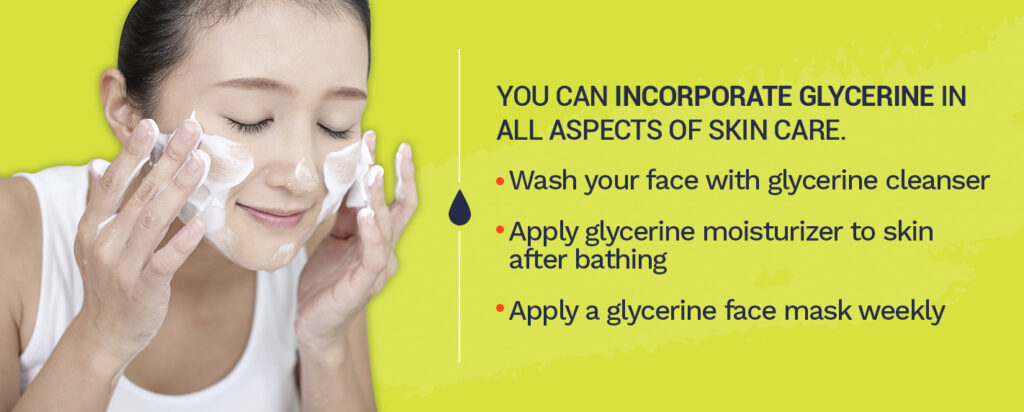
1. Facial Cleanser
The AAD recommends washing your face twice a day — once in the morning and once at night, and especially after sweating. You can use this homemade glycerine facial cleanser to clean and moisturize skin effectively. To get started, you’ll need the following ingredients:
- 1/2 cup distilled water
- 1 1/2 tablespoon vegetable glycerine
- 1 1/2 tablespoon cornstarch
- Glass jar with lid, heatproof
To make the glycerine facial cleanser, take these steps:
- Mix the water with the glycerine and cornstarch in the jar
- Put the lid on the jar
- Place the jar in a pot of water on the stove
- Bring the water to a boil
- Heat the jar until the mixture becomes clear
- Remove the jar and let it cool
Once the cleanser has completely cooled, it’s time to enjoy your creation. Here’s how to apply your homemade facial cleanser:
- Dampen your skin with lukewarm water
- Gently massage about a teaspoon of the mixture onto your skin using your fingertips
- Rinse with lukewarm water
- Pat dry with a soft towel
Apply glycerine toner and moisturizer after washing your face for optimum benefits.
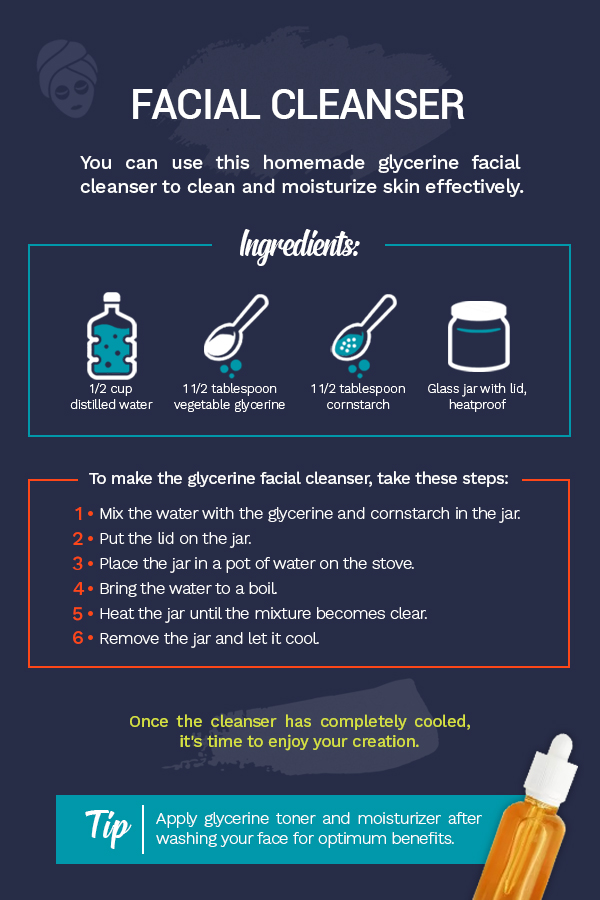
2. Hydrating Toner
Using a toner prepares the skin for a moisturizer after washing the face. A toner helps to get rid of any excess dirt or oil that may be left behind after washing. If you don’t use a toner, it may be time to consider making it part of your routine. There are several benefits of using a toner, including that it:
- Helps balance your skin’s pH level for a bright, smooth appearance
- Helps remove toxins from the skin to reduce acne and slow aging
- Shrinks and tightens pores to keep toxins from entering the skin
- Helps prevent future breakouts by removing oil and dead skin cells
- Hydrates and moisturizes skin creating a youthful radiance
In short, a toner hydrates your skin before locking in moisture. It’s important to both hydrate and moisturize your skin — there’s a difference between dehydrated skin and dry skin. Dehydrated skin lacks water, not oil. Dry skin, on the other hand, produces less oil than normal skin. So, it’s possible to have oily and dehydrated skin at the same time. Dehydrated skin may be caused by weather, diet or caffeine consumption. You can test your skin’s hydration levels by doing the following:
- Pinch your cheek
- Look for wrinkles under gentle pressure
If you see wrinkles with slight pressure, your skin needs water. Using a toner, drinking plenty of water, and eating a diet rich in fruits and vegetables can help hydrate your skin. Apply a toner containing glycerine before you moisturize. You can make this simple DIY All-Natural Hydrating Face Toner for everyday use. You’ll need the following ingredients:
- 3 to 4 tablespoons alcohol-free witch hazel
- 1/4 teaspoon vegetable glycerine
- 2-ounce glass bottle
All you’ll need to do is:
- Add both ingredients to the bottle
- Put the lid on the bottle and shake until ingredients are combined
You might choose a spray bottle for convenience, or you can apply the toner with cotton balls. After gently washing and patting your face so that the skin is damp, spray the toner three to four times over your entire face or use a cotton ball. Your skin will then be ready for a moisturizer.
3. Facial Moisturizer
After you wash your face and apply toner, you’ll want to use glycerine for skin moisturizing. Applying a glycerine face moisturizer will reduce wrinkles and keep skin soft and smooth. This is especially important if you suffer from dry, itchy skin. Dry skin commonly appears around eyebrows, the nose and the mouth. Try this recipe for a facial moisturizer, which can be made to work for all skin types. You’ll need:
- 1/2 cup distilled water or rose water
- 1 teaspoon vegetable glycerine
- 1 teaspoon cold-pressed vegetable oil
- 5 drops essential oil of your choice
- 6-ounce spray bottle, glass or plastic
- Small mixing bowl
- Wire whisk
When choosing an essential oil, consider your skin type. Here are a few tips to help you decide:
- All Skin Types: Choose lavender or rose oil
- Dry Skin: Choose cedarwood or rosewood
- Oily Skin: Choose lemon or orange oil
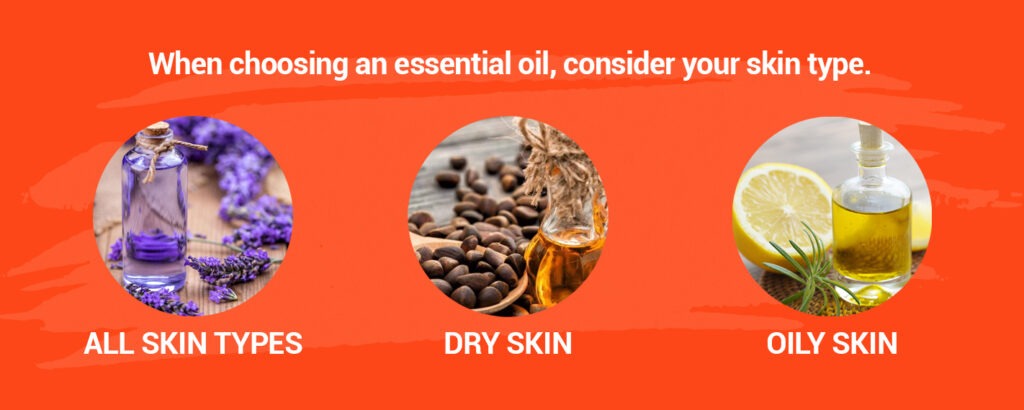
You’ll also want to consider your skin type when choosing your vegetable oil:
- All Skin Types: Choose sweet almond or apricot oil
- Dry Skin: Choose avocado oil
- Oily Skin: Choose peanut or sesame oil
Once you have all your ingredients, follow these steps to make the moisturizer:
- Add the water and glycerine to the bowl
- Stir with the whisk until combined
- Add vegetable oil and whisk
- Add essential oil and whisk
- Pour mixture into the bottle
Store the moisturizer in a cool, dry place and keep it out of direct sunlight. You can keep it fresher longer by storing it in the refrigerator. Apply the moisturizer daily after washing your face or using a toner. You can spritz it on the skin or apply the moisturizer with a cotton ball.
4. Moisturizer for Acne-Prone Skin
Acne is the most common skin condition in the United States. Although some people have more sensitive skin than others, anyone can get acne at any time in their life.
Acne is the result of clogged pores. Under normal circumstances, dead skin cells rise to the surface and fall from the body. When the body produces lots of oil, the dead skin cells can stick together and become trapped in a pore. Sometimes, bacteria get trapped in a pore and quickly multiply. The pore can become inflamed and turn into a cyst if it goes deep into the skin.
Although there are several causes of acne breakouts, from undergoing hormonal changes to sweating, you can keep pores from getting clogged by following a skin care routine. Part of this routine includes a moisturizer.
People who have frequent acne breakouts may avoid moisturizer thinking it will make their skin more oily and make acne worse. However, moisturizer may actually help reduce skin irritation and prevent acne if your skin becomes dry. For example, if you use cleansers made especially for treating acne, your skin might get dry. When skin becomes dry, your body produces more oil, which can clog pores and lead to a breakout.
If you suffer from acne, the AAD recommends looking for moisturizers that are:
- Free of oil
- Non-comedogenic
Glycerine is the perfect ingredient for a moisturizer for acne-prone skin because it is both of the above. If you struggle with acne, consider making this very easy oil-free Homemade Glycerine Skin Moisturizer. To get started, you’ll need the following ingredients:
- 1/4 cup vegetable glycerine
- 1 cup distilled water
- Spray bottle
Simply combine the ingredients in the spray bottle and shake to mix. You can spray the moisturizer directly onto the skin or apply it with cotton balls. Dermatologists recommend using a moisturizer every day whenever your skin feels dry — even if you often experience breakouts. You should apply moisturizer after you wash your skin to trap in the moisture and keep your skin beautifully hydrated.
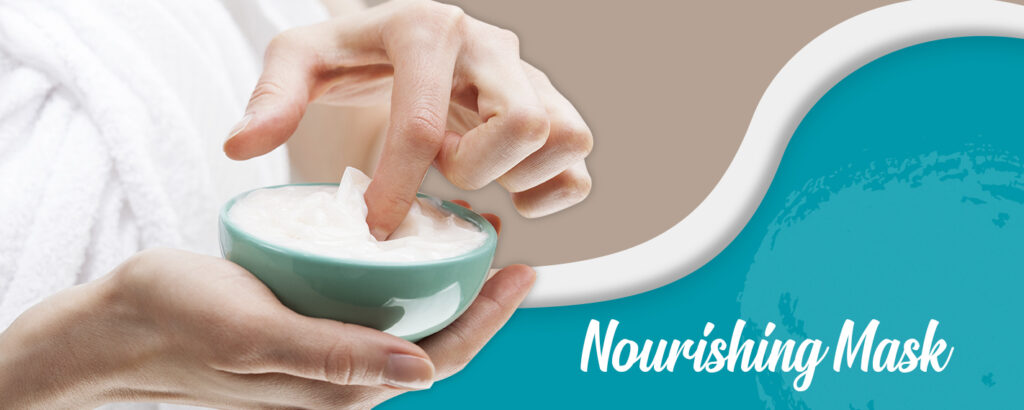
5. Nourishing Mask
Face masks give an instant beauty boost by absorbing excess oil, hydrating skin and reducing inflammation and dryness. This glycerine face mask, in particular, holds in moisture and works great to soothe dry skin. To make a nourishing glycerine face mask, you’ll need the following:
- 3 teaspoons white kaolin clay
- 1/2 teaspoon bentonite clay
- 1/2 teaspoon vegetable glycerine
- 5 teaspoons water
- 2 drops rose geranium essential oil
To make the mask, take these steps:
- Mix the white kaolin clay and bentonite in a bowl
- Stir in the glycerine, water and essential oil
- Spread the mask onto your face using circular motions
- Allow the mask to dry completely before rinsing
There are ways to make a face mask work even better. Here are some tips for getting the most out of the face mask:
- Clean your skin before applying the mask to open and unclog pores
- Close your pores after using the mask to lock in ingredients by washing off the mask with cold water
- Apply moisturizer to seal in mask ingredients
6. Anti-Aging Mask
This simple face mask recipe uses natural ingredients to balance out skin tone and incorporates glycerine as a moisturizer. All you’ll need is:
- One egg white
- 1 teaspoon vegetable glycerine
- 1 teaspoon honey
To make the mask you’ll:
- Beat the egg white until it’s frothy
- Mix in the glycerine and honey
- Apply the mixture to your face in circular strokes
- Leave the mask on for 20 minutes
- Rinse with cool water
- Pat dry and apply moisturizer
Use this mask to temporarily tighten skin and reduce wrinkles — perfect for a night on the town. The protein in the egg white along with the glycerine helps to tighten and hydrate the skin for a stunning appearance.
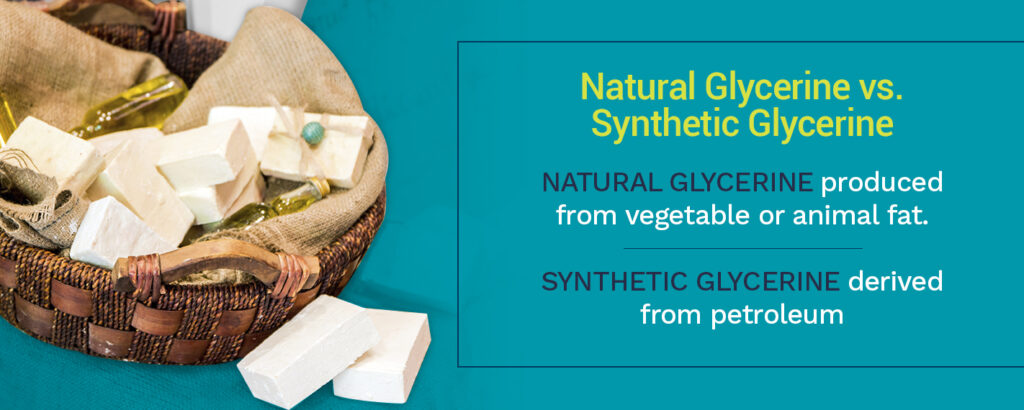
7. All-Over Soap
You can treat your entire body to gentle, moisturizing glycerine soap. Glycerine soap is the ideal cleanser for individuals with sensitive skin. To make glycerine soap, you need plant oil like coconut or vegetable oil, lye, alcohol, liquid glycerine and distilled water. Lye requires careful handling, so we’re going to share a recipe that doesn’t require lye but will still provide an effective glycerine soap bar.
Try this Soothing DIY Glycerine Soap recipe to easily and safely make glycerine soap at home. You’ll need the following ingredients:
- 2 cups vegetable glycerine
- 2 cups water
- 2 cups grated bar soap
- 20 drops essential oil, optional
- Parchment paper
- Soap mold
To make the glycerine soap bars, take these steps:
- Combine glycerine, water and grated soap in a pot
- Heat on the stove over medium heat
- Stir frequently and keep heating until the soap is completely dissolved
- Remove the pot from the heat and add in essential oil if desired
- Line a mold, such as a cake pan, with parchment paper
- Pour the mixture into the mold
- Let the soap harden for 48 hours
- Remove the soap from the mold once it’s hard
- Slice the soap with a sharp knife
- Lay the sliced bars on cooling racks
- Let the bars of soap sit for two weeks to ensure they are solid
- Store in containers
Don’t want to make soap but still want the power of glycerine? You can also add a few drops of glycerine to your regular body wash for a moisturizing boost.
9. Cracked Heel Remedy
Cracked heels are a common problem and usually are only a cosmetic issue. However, in some cases cracks can be deep and painful. Glycerine helps skin feel and look healthier and more supple. You can use glycerine by mixing it with your favorite moisturizing foot cream every night before bed or you can try this foot mask recipe to remedy cracked heels. To get started, you’ll need:
- 2 tablespoons vegetable glycerine
- 2 teaspoons rose water
- 1 tablespoon salt
- 1/2 cup lemon juice
- Warm water
- A pumice stone or foot scrubber
Once you’ve gathered your ingredients, take these steps:
- Fill a basin with warm water
- Add the salt, eight to 10 drops of lemon juice, one tablespoon of glycerine and one teaspoon of rose water
- Soak your feet for about 20 minutes
- Scrub your heels and the sides of your feet using the pumice stone
- Mix one teaspoon of glycerine, one teaspoon of rose water and one teaspoon of lemon juice in a bowl
- Apply the mixture to your heels
- Put on socks and leave the mixture on overnight
- Wash your feet with lukewarm water in the morning
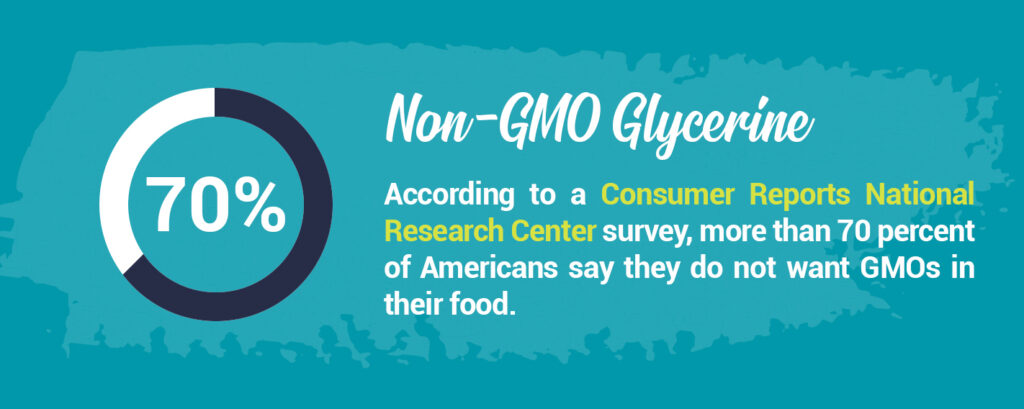
10. Cheek Stain
This recipe shows you fun and easy ways to use glycerine in cosmetics. It’s simple to make your own cosmetics at home with ingredients you choose. When you make cosmetics, you don’t have to worry about what you’re putting on your skin. Also, when you add glycerine to your homemade cosmetics, you get to enjoy beauty products that also moisturize. Try this simple DIY Beet Cheek Stain recipe, which calls for:
- 1 to 2 tablespoons vegetable glycerine
- 1 red beet, sliced
- Glass jar, heatproof
To make the cheek stain, take these steps:
- Place the beet slices and glycerine in the glass jar
- Place the jar in a pot of boiling water
- Boil for 20 to 30 minutes
- Strain the mixture into a glass container
- Once cooled, place a drop in the palm of your hand
- Blend the stain into your cheeks using your fingertips
Buy Natural Glycerine for Skin Care
If you’re looking for a natural glycerine supplier, reach out to us at Acme-Hardesty. As a company that started 70 years ago, Acme-Hardesty is your trusted natural ingredient supplier. We are the largest distributor of bio-based solutions, and we offer a full range of renewable palm-based (vegetable) glycerine. Our natural food-grade glycerine is 99.7 percent kosher. We also offer the option to buy non-GMO glycerine.
To buy kosher glycerine to use in your skin care routine or DIY skin care products, or to make your customers smile, shop our products online today. Have questions or need assistance? Feel free to contact us for more information.
